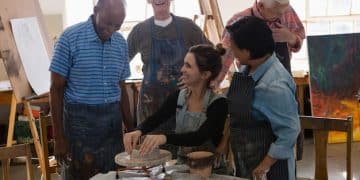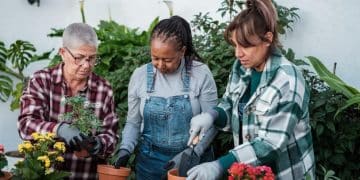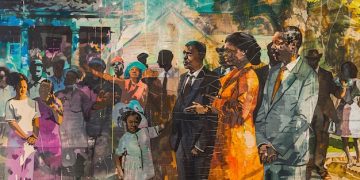How to Create a Community Art Project: Enhancing Public Spaces
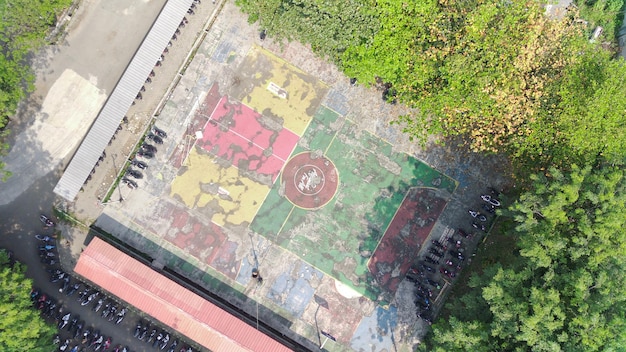
Creating a community art project can transform public spaces by fostering engagement, promoting inclusivity, and enhancing the aesthetic appeal of neighborhoods through collaborative artistic endeavors.
Want to revitalize your neighborhood and foster a stronger sense of community? Creating a community art project is a powerful way to enhance public spaces, bringing people together and injecting creativity into everyday life.
Understanding the Power of Community Art
Community art projects are more than just visually appealing additions to public spaces. They’re powerful tools for social change, community building, and civic engagement. They provide platforms for diverse voices to be heard and create opportunities for residents to collaborate and connect.
Benefits of Community Art
Community art projects offer numerous benefits that extend beyond aesthetics. They can improve public safety, promote economic development, and enhance the overall quality of life in a neighborhood.
- Increased Community Pride: Public art can instill a sense of ownership and pride among residents, making them more invested in their neighborhood.
- Enhanced Social Cohesion: Collaborative art projects bring diverse groups together, fostering dialogue and understanding.
- Improved Public Spaces: Art can transform neglected or underutilized spaces into vibrant, welcoming areas that attract residents and visitors.
- Economic Revitalization: Public art can attract tourists and businesses, boosting the local economy.
Consider the High Line in New York City, a former elevated railway line transformed into a public park featuring rotating art installations. This project not only revitalized a derelict space but also became a major tourist attraction, boosting the local economy and enhancing the city’s cultural landscape.
Community art fosters pride, cohesion, improves spaces, and aids economic revitalization. These benefits illustrate the value of starting such a project.
Identifying Community Needs and Opportunities
Before diving into the creative process, it’s essential to identify the specific needs and opportunities within your community. This involves engaging with residents, understanding their concerns, and assessing the potential impact of your art project.
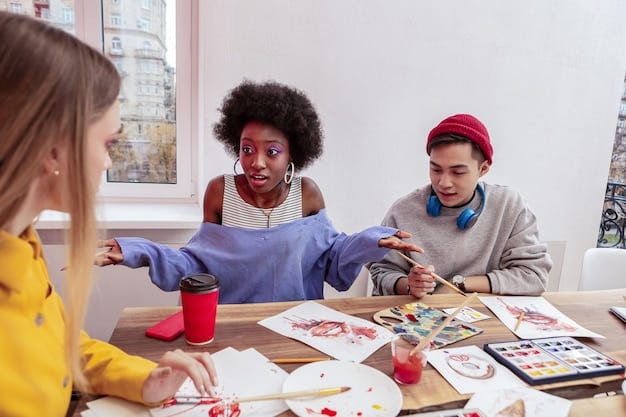
Conducting Community Research
Effective community art projects are rooted in thorough research and engagement. This ensures that the project reflects the values and aspirations of the community it serves.
- Surveys and Questionnaires: Gather data on residents’ preferences, concerns, and ideas for public art.
- Community Meetings: Host open forums to discuss potential project ideas and gather feedback from residents.
- Site Assessments: Evaluate potential locations for the art project, considering factors such as visibility, accessibility, and safety.
Imagine a neighborhood grappling with high crime rates and neglected public spaces. Through community research, residents might express a desire for a vibrant mural that celebrates their cultural heritage and promotes a sense of safety. By addressing these specific needs, the art project can have a tangible impact on the community.
Researching community input through surveys, community meetings, and site assessments is key to understanding the community’s needs.
Securing Funding and Resources
Funding is often a critical component of any community art project. Fortunately, there are many avenues for securing financial support, from grants and sponsorships to fundraising events and crowdfunding campaigns.
Exploring Funding Options
A well-defined fundraising strategy is essential for securing the resources needed to bring your community art project to life. Explore a variety of funding options to diversify your sources of support.
- Grants: Research local, state, and national grant programs that support community arts initiatives.
- Sponsorships: Partner with local businesses to secure financial or in-kind contributions.
- Fundraising Events: Organize events such as art auctions, benefit concerts, or community festivals to raise funds.
For example, a local arts council might offer grants specifically for community-based projects. A nearby business could sponsor the cost of materials in exchange for recognition on the artwork. Or a community could host a fundraising auction featuring artwork donated by local artists.
Grants are a great place to start, but don’t forget about community fundraising events or sponsorships from local businesses to make your art project happen.
Designing and Planning the Art Project
With funding secured and community input gathered, it’s time to start designing and planning the specifics of your art project. This involves selecting an appropriate medium, developing a cohesive design, and creating a detailed project timeline.
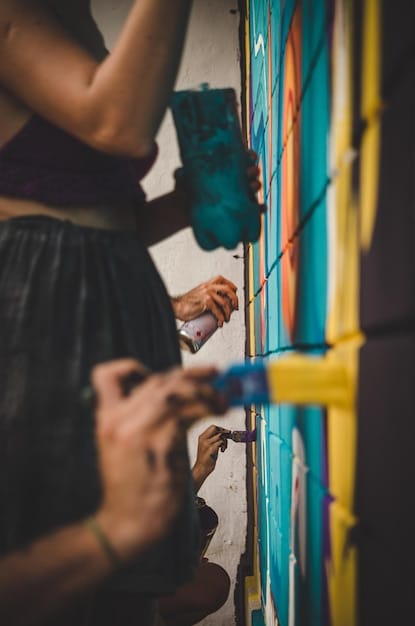
Choosing the Right Medium
The medium you choose for your art project will depend on various factors, including the location, the budget, and the skills of the artists involved. Consider options such as:
Murals, Sculptures, Mosaic Art.
Developing a Project Timeline
A well-defined project timeline is essential for keeping your community art project on track and ensuring that all tasks are completed in a timely manner.
Break down the project into smaller, manageable tasks, assign responsibilities, and set deadlines for each task. Regularly monitor progress and make adjustments as needed. For instance, a mural project might involve steps such as:
- Design development (2 weeks).
- Surface preparation (1 week).
- Painting (4 weeks).
Choosing the right medium and planning out your timeline will help ensure your art project is a success.
Engaging the Community in the Creative Process
Community art projects thrive on collaboration and participation. Involving residents in the creative process from start to finish fosters a sense of ownership and ensures that the artwork truly reflects the community’s identity.
Organizing Workshops and Volunteer Opportunities
Create opportunities for residents to contribute their skills and talents to the art project. Organize workshops where people can learn new techniques, or invite volunteers to assist with tasks such as painting, sculpting, or mosaic tiling.
Consider a community garden project where residents of all ages and backgrounds come together to plant flowers, build raised beds, and create decorative elements. This hands-on involvement fosters a sense of community and pride in the shared space.
When working with community members it is important to organize workshops or volunteer opportunities for your project.
Maintaining and Sustaining the Art Project
Ensuring the long-term durability and impact of your community art project requires ongoing maintenance and community support. Develop a plan for preserving the artwork, addressing potential damage, and ensuring that it continues to serve the community for years to come.
Preservation and Care
Protecting your community art project from the elements and potential damage is essential for ensuring its longevity. Implement measures such as:
- Anti-graffiti coatings.
- Regular cleaning and repairs.
- Protective barriers.
Additionally, foster a sense of stewardship among community members by encouraging them to report any vandalism or damage and to participate in ongoing maintenance efforts.
Making sure there is ongoing maintenence and care will ensure the art project continues to serve the community for years to come.
Celebrating Success and Building Momentum
Once your community art project is complete, take the time to celebrate your success and acknowledge the contributions of everyone involved. This not only fosters a sense of accomplishment but also builds momentum for future community initiatives.
Organizing a Grand Opening
Host a grand opening event to showcase the artwork and celebrate the community’s collective achievement. Invite local officials, community leaders, and residents of all ages to participate in the festivities.
Share the story of your community art project through local media, social media, and community newsletters. Highlight the positive impact it has had on the neighborhood and the individuals involved. This can inspire other communities to embark on similar initiatives.
After the project is complete, consider hosting a grand opening to celebrate the collective achievement.
| Key Points | Brief Description |
|---|---|
| 🎨 Community Benefits | Boosts pride, enhances cohesion, and revitalizes spaces. |
| 🤝 Community Engagement | Crucial for understanding needs and gaining support. |
| 💰 Funding Options | Explore grants, sponsorships, and community fundraising. |
| 📅 Project Timeline | Essential for staying on track and managing tasks. |
FAQ
▼
A community art project is any artistic endeavor designed to engage and involve local residents in the creation or appreciation of art within a public space. It aims to reflect community values and enhance the environment.
▼
Start by hosting open meetings and workshops. Actively seek input through surveys and invite volunteers to participate in all phases of the project—from planning and design to creation and maintenance—to foster ownership and enthusiasm.
▼
Look for grants from local arts councils, state government programs, and national foundations that support community arts initiatives. Also, approach local businesses for sponsorships and organize community fundraising events to gather financial support.
▼
Challenges may include securing sufficient funding, managing diverse opinions within the community, obtaining necessary permissions, and ensuring ongoing maintenance and protection of the artwork from vandalism or wear and tear.
▼
Success can be gauged by increased community involvement, positive feedback from residents, enhanced public spaces, and a stronger sense of community pride. Document these outcomes through surveys, testimonials, and visual records of the project’s impact.
Conclusion
Creating a community art project is a transformative journey that can breathe new life into public spaces while fostering a stronger sense of belonging and pride. By following these steps, you can empower your community to create a lasting legacy that enriches lives for generations to come.
